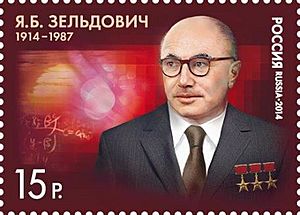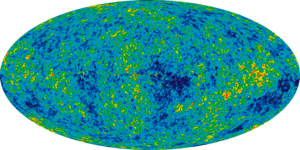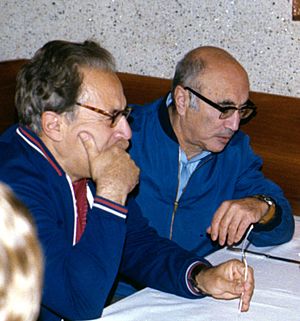Yakov Zeldovich facts for kids
Quick facts for kids
Yakov Zeldovich
|
|
|---|---|
| Яков Зельдович | |

Zeldovich on a 2014 Russian postage stamp
|
|
| Born |
Yakov Borisovich Zeldovich
8 March 1914 |
| Died | 2 December 1987 (aged 73) |
| Resting place | Novodevichy Cemetery, Moscow |
| Alma mater | Saint Petersburg State University |
| Known for | Zeldovich approximation Zeldovich antidynamo theorem Zeldovich equation of state Zeldovich factor Zeldovich mechanism Zeldovich number Zeldovich pancake Zeldovich radiation Zeldovich streaming model Zeldovich regularization Zeldovich spontaneous wave Zeldovich–Liñán model Zeldovich–Taylor flow BZT fluid Harrison–Zeldovich spectrum Sunyaev–Zeldovich effect ZND detonation model Shvab–Zeldovich formulation ZFK equation Activation energy asymptotics Diffusive–thermal instability Gravitational memory effect Method of matched asymptotic expansions Primordial black hole Self-similar solution of the second kind Vector current conservation hypothesis |
| Awards | Friedmann Prize (2002) Dirac Medal (1985) Gold Medal of the Royal Astronomical Society (1983) Bruce Medal (1983) Kurchatov Medal (1977) Lenin Prize (1957) Hero of Socialist Labor (1949, 1954, 1956) |
| Scientific career | |
| Fields | Physics |
| Institutions | Institute of Chemical Physics Moscow State University Sternberg Astronomical Institute |
| Thesis | Theory of Nitrogen Oxidation (1939) |
| Doctoral advisor | Aleksandr Frumkin |
| Doctoral students |
|
| Other notable students | Rashid Sunyaev Roman Juszkiewicz Igor Novikov Sergei Shandarin Alexei Starobinsky Vladimir M. Lipunov Victor Shvartsman Varun Sahni Deborah Dultzin |
| Physical cosmology | ||||||||||||||
 |
||||||||||||||
| Universe · Big Bang Age of the universe Timeline of the Big Bang Ultimate fate of the universe
|
||||||||||||||
Yakov Borisovich Zeldovich (born March 8, 1914 – died December 2, 1987) was a very important physicist from the Soviet Union. He was also known as YaB.
He made many big discoveries in different areas of physics. These included how the universe began and changed (called physical cosmology), how thermonuclear reactions work, how things burn (combustion), and how liquids and gases move (hydrodynamics).
Starting in 1943, Zeldovich played a key part in the Soviet Union's nuclear weapons program. He taught himself much of what he knew. In 1963, he went back to working in universities. There, he made new discoveries about black holes and helped us understand the universe better.
Contents
About Yakov Zeldovich
His Early Life and Learning
Yakov Zeldovich was born in Minsk, a city in what is now Belarus. His family was Jewish. In 1914, his family moved to Saint Petersburg. They lived there until 1941.
During World War II, his family had to move to Kazan to be safe. This was because of the war in the Soviet Union. In 1943, Zeldovich moved to Moscow.
His father, Boris Naumovich Zeldovich, was a lawyer. His mother, Anna Petrovna Zeldovich, translated books from French to Russian. She was also a writer. Even though his family was religious, Zeldovich himself did not believe in God.
Zeldovich was a self-taught person. This means he learned a lot on his own. People thought he was very smart and could understand many different things. He made important contributions to many science topics.
In 1931, he got a job as a helper in a lab. This was at the Institute of Problems of Chemical Physics. He worked there for the rest of his life. As a lab helper, he learned about physical chemistry. He became well-known among the older scientists there.
From 1932 to 1934, Zeldovich took classes in physics and mathematics. He studied at Saint Petersburg State University and Peter the Great St. Petersburg Polytechnic University.
In 1936, he earned his first science degree, like a PhD. His work was about how things stick to surfaces and how chemical reactions happen on them. He found the scientific reason for something called the Freundlich adsorption isotherm.
In 1939, Zeldovich earned a higher degree in mathematical physics. His work was about how nitrogen turns into other chemicals. He discovered a process called the Zeldovich mechanism. This mechanism explains how nitrogen oxides form at high temperatures.
Working on Nuclear Weapons
Zeldovich was a very important, but secret, person in the Soviet nuclear weapons program. He was not allowed to travel much outside the Soviet Union.
After Otto Hahn discovered nuclear fission in 1939, Russian scientists began studying it. Igor Kurchatov and Yulii Khariton started working on this in 1940.
In May 1941, Zeldovich and Khariton worked together. They created a theory about how nuclear reactions happen. This was when the conditions were just right for a reaction to keep going. Their work also helped explain how things ignite, burn, and explode.
The modern theory of explosions is partly named after Zeldovich. It is called the Zeldovich-von Neumann-Dohring (ZND) theory. This work was delayed because of the German invasion in 1941.
In 1942, Zeldovich was sent to Kazan. He was asked to work on regular gunpowders for the Soviet Army. Khariton worked on designing new types of weapons.
In 1943, Joseph Stalin decided to build nuclear weapons. Igor Kurchatov was in charge. Kurchatov asked Stalin to bring Zeldovich and Khariton to Moscow. They joined the nuclear weapons program.
Zeldovich joined Kurchatov's small team in a secret lab in Moscow. He started working on the theory of nuclear burning. In 1946, he became the head of the theory department at Arzamas-16. This was a secret city for nuclear research.
Zeldovich and other scientists wrote a report. It was about whether nuclear fusion could release energy. This fusion would be started by an atomic explosion. Zeldovich learned from other physicists who had worked on the American Manhattan Project.
In 1949, Zeldovich led a team that did the first nuclear test. This test, called RDS-1, was based on an American design. He continued his important work on how explosions happen.
Zeldovich then started working on making nuclear weapons better. He first thought of the idea for the hydrogen bomb. He shared this idea with Andrei Sakharov and others. While working on nuclear weapons, Zeldovich also made big discoveries. These were about how radiation moves in liquids and gases, and how matter behaves under very high pressure.
Between 1950 and 1953, Zeldovich did calculations for the hydrogen bomb. Andrei Sakharov checked these calculations. Even though they worked separately, Sakharov later found a new way to approach thermonuclear fusion. Zeldovich stayed involved with the nuclear testing program. He led labs at Arzamas-16 until 1963. Then, he left to work in universities.
Academia and the Universe
In 1952, Zeldovich began studying elementary particles. These are the smallest pieces of matter. He predicted that a pi meson particle could undergo beta decay. With Semyon Gershtein, he saw how weak forces and electromagnetic forces were similar.
In 1960, he predicted something called muon catalysis. This is when a muon particle helps nuclear fusion happen. In 1977, Zeldovich received the Kurchatov Medal. This was the highest award for nuclear physics in the Soviet Union. He won it for predicting and studying ultracold neutrons.
He became a full member of the USSR Academy of Sciences in 1958. From 1965 to 1983, he led a division at the Keldysh Institute of Applied Mathematics.
In the early 1960s, Zeldovich started working on astrophysics and physical cosmology. These are studies about stars, galaxies, and the universe. In 1964, he and Edwin Salpeter were the first to suggest something important. They thought that spinning disks of gas around huge black holes create the massive energy seen from quasars.
From 1965, he was a professor at Moscow State University. He also led the Relativistic Astrophysics division at the Sternberg Astronomical Institute. In 1966, he and Igor Novikov suggested how to find black holes. They said to look for star systems where one star is bright but doesn't give off X-rays, and the other is dark but gives off X-rays.
Zeldovich studied how the hot universe changed over time. He also looked at the microwave background radiation. This is leftover heat from the Big Bang. He studied the large-scale structure of the universe and the theory of black holes.
He and Rashid Sunyaev predicted something called the Sunyaev-Zeldovich effect. This is when the cosmic microwave background changes as it passes through galaxy clusters. Telescopes like the Atacama Cosmology Telescope have confirmed this effect. It helps scientists study how galaxy clusters form. Zeldovich also helped us understand how the universe's large structures formed.
In 1974, with A. G. Polnarev, he suggested the gravitational memory effect. This means that if gravitational waves pass by, particles that were still will move.
Black Hole Evaporation
Zeldovich was very important in developing the idea of black hole evaporation. This is when black holes slowly lose energy. In 1971 and 1972, Zeldovich and Charles W. Misner predicted that spinning Kerr black holes could create and release particles.
Earlier, in 1965, Zeldovich had predicted that Kerr black holes would split the light from photons. This is similar to how a magnetic field affects light (Zeeman effect). In 1973, Stephen Hawking visited Moscow. Zeldovich and Alexei Starobinsky showed Hawking that rotating black holes should create and emit particles. This happens because of the rules of quantum mechanics.
His Family
Yakov Zeldovich and his wife, Varvara Pavlovna Konstantinova, had three children. All of them became physicists. Their son was Boris Zeldovich. Their daughters were Olga Yakovlevna Zeldovich and Marina Yakovlevna Zeldovich.
Zeldovich also had another daughter named Annushka with O.K. Shiryaeva.
In 1945, he had another daughter, Alexandra Varkovitskaya, with Ludmila Varkovitskaya.
He had another son, Leonid Yakovlevich Agapov, with Nina Nikolaevna Agapova in 1958. Leonid passed away in 2016.
Awards and Honors
Igor Kurchatov called Zeldovich a "genius." Andrei Sakharov said he was "a man of universal scientific interests." After meeting him, Stephen W. Hawking wrote to Zeldovich: "now I know that you are a real person and not a group of scientists."
Zeldovich was a member of several important science groups. These included the American Academy of Arts and Sciences (1975), the United States National Academy of Sciences (1979), and the American Philosophical Society (1979).
- Dirac Medal of the ICTP (1985)
- Bruce Medal (1983)
- Gold Medal of the Royal Astronomical Society (1984)
- Kurchatov Medal (1977)
- Three times Hero of Socialist Labor (1949, 1953, 1957)
- Stalin Prize (1943, 1949, 1951, 1953)
- Lenin Prize (1957)
- Three Orders of Lenin (1949, 1962, 1974)
- Two Orders of the Red Banner of Labour (1945, 1964)
- Order of the October Revolution (1962)
- An asteroid called 11438 Zeldovich was named after him in 2001.
See also
In Spanish: Yákov Zeldóvich para niños


